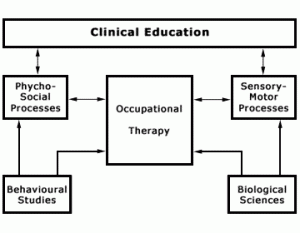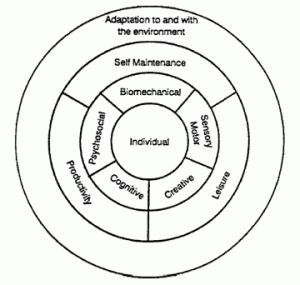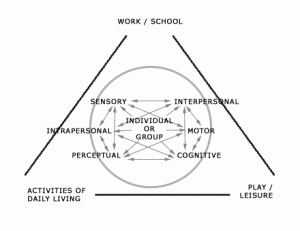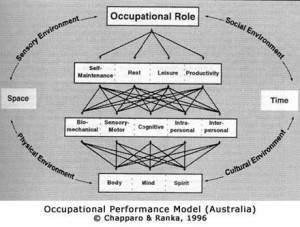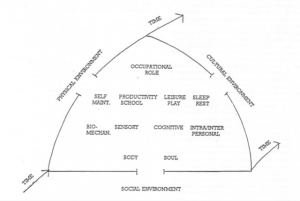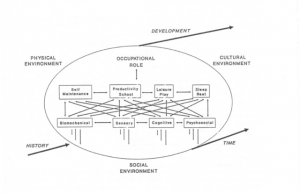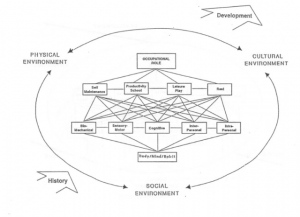REFERENCES
Adams, M., & Shepherd, B. (1994). Use of theoretical models in a transitional living unit. Paper presented at The New South Wales Association of Occupational Therapists 7th State Conference, Newcastle, NSW, Australia.
Alexander, P., Keogh, M. & Cheesman, G. (1980). Occupational therapy workforce study. (Available from The New South Wales Association of Occupational Therapists, PO Box 142, Ryde, NSW, Australia, 2112.
American Occupational Therapy Association, Inc. (1973). The roles and functions of occupational therapy personnel. Rockville, MD: Author.
American Occupational Therapy Association, Inc. (1974). A curriculum guide for occupational therapy educators. Rockville, MD: Author
American Occupational Therapy Association, Inc. (1979). Uniform terminology system for reporting occupational therapy services. Rockville, MD: Author.
American Occupational Therapy Association, Inc. (1989). Uniform terminology for occupational therapy: Second edition. American Journal of Occupational Therapy, 43, (12) 808-815.
Ãrnadóttir, G. (1990). The brain and behaviour: Assessing cortical dysfunction through activities of daily living. St. Louis: C.V.Mosby.
Barnett, D., & Hummell, J. (1993, October). Performance indicators for occupational therapists: Working with children and their families. Paper presented at The New South Wales Association of Occupational Therapists 6th State Conference, Mudgee, NSW, Australia.
Barris, R. (1982). Environmental interactions: an extension of the model of occupation. American Journal of Occupational Therapy, 36, 637-644.
Chapparo, C.J. (1996, September). A model of occupational performance: expanding the concept of performance. Invited key note paper presented at the Österreichischer Ergotherapiekongress, Vienna, Austria
Chapparo, C.J., & Hummell, J. (1992a). Sensory integration therapy: Application of theory to treatment of children with learning and developmental disorders. Course presented for New South Wales Association of Occupational Therapists.
Chapparo, C.J., & Hummell, J. (1992b). Sensory integration therapy: Application of theory to treatment of children with learning and developmental disorders. Course presented for The Paediatric and Adolescent Action Group of the South Australia Association of Occupational Therapists, Adelaide.
Chapparo, C.J. & Ranka, J.L. (1990, November). Occupational performance and the acquisition of adaptive skills in brain damaged adults: 1 – Using task analysis to identify problems and structure treatment for adults with brain impairment. Course presented for The New South Wales Association of Occupational Therapists, Sydney.
Chapparo, C.J., & Ranka, J.L. (1991a). Identification of information processing deficits in adults with brain injury. Unpublished research report. (Available from Faculty of Health Science, The University of Sydney, P.O.Box 170, Lidcombe, NSW, Australia 2141).
Chapparo, C.J. & Ranka, J.L. (1991b, February). Occupational performance and the acquisition of adaptive skills in brain damaged adults: 2 – Neurodevelopmental Therapy. Course presented for The New South Wales Association of Occupational Therapists, Sydney.
Chapparo, C.J. & Ranka, J.L. (1991c, April). Occupational performance and the acquisition of adaptive skills in brain damaged adults: 3 – Proprioceptive Neuromuscular Facilitation. Course presented for The New South Wales Association of Occupational Therapists, Sydney.
Chapparo, C.J. & Ranka, J.L. (1991d, May). Occupational performance and the acquisition of adaptive skills in brain damaged adults: 4 – Upper limb orthotic systems. Course presented for The New South Wales Association of Occupational Therapists, Sydney.
Chapparo, C.J. & Ranka, J.L. (1991e, June). Occupational performance and the acquisition of adaptive skills in brain damaged adults: 5 – Motor planning, motor learning and occupational performance. Course presented for The New South Wales Association of Occupational Therapists, Sydney.
Chapparo, C.J. & Ranka, J.L. (1991f, August). Occupational performance: A model for practice. Course presented for The New South Wales Association of Occupational Therapists, Sydney.
Chapparo, C.J. & Ranka, J.L. (1992a, September). Motor planning, motor learning and occupational performance. Course presented for The Victorian Association of Occupational Therapists, Melbourne.
Chapparo, C.J. & Ranka, J.L. (1992b, September). Motor planning, motor learning and occupational performance. Course presented for The Tasmanian Association of Occupational Therapists, Launceston.
Chapparo, C. J., & Ranka, J.L. (1995, September). Occupational performance. Invited presentation to the Neuro Special Interest Group of OT Australia AAOT-NSW, Sydney.
Christiansen, C. (1991). Occupational therapy: intervention for life performance. In C. Christiansen, & C. Baum (Eds), Occupational therapy: overcoming human performance deficits (pp 3-44). Thorofare, NJ: Slack, Inc.
Clark, F.A., Parham, D., Carlson, M.E., Frank, G., Jackson, J., Pierce, D., Wolfe, R.J. & Zemke, R. (1991). Occupational science: Academic innovation in the service of occupational therapy’s future. American Journal of Occupational Therapy, 45(4), 577-585.
Colvin, M.E., & Korn, t.L. (1984). Eliminating barriers to the disabled. American Journal of Occupational Therapy, 38, 159-173.
Colyer, S. (1994, September). The use of a model of O.T. practice in a rehabilitation setting. Paper presented at The New South Wales Association of Occupational Therapists 7th State Conference, Newcastle, NSW Australia.
Dunn, W.W. (1988). Uniform terminology grid: A framework for applying uniform terminology to occupational therapy practice. Unpublished grid. (Available from author
Dunn, W.W., & McGourty, (1989). Application of Uniform Terminology to practice. American Journal of Occupational Therapy, 42(12), 817-831.
Fidler, G.S., & Fidler, J.W. (1978) Doing and becoming: Purposeful action and self-actualization. American Journal of Occupational Therapy, 32, 305-310.
Fisher, A. G. (1990). Assessment of motor and process skills (research ed. 5R). Unpublished test manual, (Available from Department of Occupational Therapy, The University of Illinois at Chicago, Chicago, Illinois).
Fisher, A. Murray, E., & Bundy, A. (1991) Sensory integration theory and practice. Philadelphia: F.A. Davis Co.
Hanrahan, M., Jackson, J., Neuss, M., & Walkling, K. (1993, October). Development of a new quantitative and qualitative information system (“Stats System”): An action research approach at The Prince of Wales Hospital. Paper presented at The New South Wales Association of Occupational Therapists 6th State Conference, Mudgee, NSW, Australia.
Heard, C. (1977) Occupational role acquisition: A perspective on the chronically disabled. American Journal of Occupational Therapy, 31, 243-247
Howe, M.C., & Briggs, A.K. (1982). Ecological systems model for occupational therapy. American Journal of Occupational Therapy, 36, 322-327.
Jackoway, I. S., Rogers, J. C., & Snow, T. (1987) The Role Change Assessment: An interview tool for evaluating older adults. Occupational Therapy in Mental Health, 1, 17-37
Keilhofner, G. (1985). A model of human occupation: Theory and application. Baltimore, MD: Williams & Wilkins.
Keilhofner, G., & Burke, J. P. (1985). Components and determinants of human occupation. In G. Keilhofner (Ed.), A model of human occupation: Theory and application (pp.17-20). Baltimore: Williams & Wilkins.
Keilhofner, G. Harlan, B., Bauer, D., & Maurer, P. (1986). The reliability of a historical interview with physically disabled respondents. American Journal of Occupational Therapy, 40(8), 551-556.
King, L. J. (1978) Toward a science of adaptive responses, 1978 Eleanor Clarke Slagle Lecture. American Journal of Occupational Therapy, 32(7), 429-437.
Law, M. (1991). The Muriel Driver Lecture: The environment: a focus for occupational therapy. Canadian Journal of Occupational Therapy, 58, 171-179.
Law, M., Baptiste, S., McColl, M., Opzoomer, A., Polatajko, H., & Pollock, A. (1990) The Canadian Occupational Performance Measure: An outcome measure for occupational therapy. Canadian Journal of Occupational Therapy, 57(2), 82-87.
Llorens, L. (1970). Facilitating growth and development: The promise of occupational therapy, 1969 Eleanor Clarke Slagle lecture. American Journal of Occupational Therapy, 24, 93-101.
Llorens, L. A. (1982). Occupational therapy client sequential care record. Laurel, MD: Ramsco Pub.Co.
Llorens, L.A. (1984). Changing balance: Environment and individual. American Journal of Occupational Therapy, 38(1), 28-34.
Matsutsuyu, J. (1971). Occupational behaviour – a perspective on work and play. American Journal of Occupational Therapy, 25, 291-294.
Meyer, A. (1922/1977) The philosophy of occupational therapy. American Journal of Occupational Therapy, 31 (11), 639-642 (Reprinted from original)
Moorhead, L. (1969) The occupational history. American Journal of Occupational Therapy, 23, 329-334.
Mosey, A. (1980) A model for occupational therapy. Occupational Therapy in Mental Health, 1, 11-32
Mosey, A.C. (1981). Occupational therapy: Configuration of a profession. New York: Raven Press
Nelson, D. L. (1984). Children with autism and other pervasive disorders of development and behaviour: Therapy through activities. Thorofare, NJ: Slack Inc.
Nelson, D. L. (1988). Occupation: Form and performance. American Journal of Occupational Therapy, 42(10), 633-641
Nicholls, J. (1993, October). Management of agitated behaviour in adults with traumatic brain injury: A case study. Paper presented at The New South Wales Association of Occupational Therapists 6th State Conference, Mudgee, NSW, Australia.
Oakley, F., Keilhofner, G., Barris, R., & Reichler, R. K. (1986). The Role Checklist: Developing empirical assessment of reliability. Occupational Therapy Journal of Research, 6, 157-170
Pedretti, L.W., & Pasquinelli, S. (1990). A frame of reference for occupational therapy in physical dysfunction. In L.W. Pedretti and B. Zoltan, (Eds.), Occupational therapy : Practice skills for physical dysfunction (3rd ed.) (pp. 1- 17). St. Louis: C.V. Mosby.
Ranka, J. (1995, September). Occupational performance: A model for practice in occupational therapy. Paper presented at The 1st Asia-Pacific Occupational Therapy Congress. Kuala Lumpur
Ranka, J. (1995, June). Occupational performance: Application to practice. Invited presentation to occupational therapists at St. George Hospital. Kogarah, NSW
Ranka, J., & Chapparo, C.. (1996, September). Occupational perforamnce: Implications for occupational therapy in psychiatric settings. Invited presentation to the Mental Health Interest Group of OT Australia AAOT-NSW,
Reed, K.L. (1984). Models of practice in occupational therapy. Baltimore: Williams & Wilkins.
Reed, K. L., & Sanderson, S.R. (1980) Concepts of occupational therapy. Baltimore: Williams & Wilkins.
Reed, K.L., & Sanderson, S. R. (1983). Concepts of occupational therapy (2nd Ed.). Baltimore: Williams & Wilkins.
Ryan, L., & Nicholls, J. (1993, October). Dysautonomia: It’s effect during upper limb splinting of comatose patients with traumatic brain injury. Paper presented at The New South Wales Association of Occupational Therapists 6th State Conference, Mudgee, NSW, Australia.
School of Occupational Therapy (1975). Stage III submission: Proposal for a degree course in occupational therapy. (Available from Faculty of Health Sciences, The University of Sydney, PO Box 170, Lidcombe, NSW, Australia 2141)
School of Occupational Therapy (1986). Stage IV review: Bachelor of applied science (occupational therapy). (Available from Faculty of Health Sciences, The University of Sydney, PO Box 170, Lidcombe, NSW, Australia 2141)
Townsend, E., Brintnell, S., & Staisey, N. (1990). Developing guidelines for client-centered occupational therapy practice. Canadian Journal of Occupational Therapy, 57, 69-76.
Vause-Earland, T. (1990). Perceptions of role assessment tools in the physical disability setting. American Journal of Occupational Therapy, 45(1), 26-31
Versluys, H. P. (1980). The remediation of role disorders through focused group work. American Journal of Occupational Therapy, 34(9), 609-614.
West, W.L. (1984). A reaffirmed philosophy and practice of occupational therapy for the 1980′s. American Jouranl of Occupational Therapy, 38(1), 15-23.
Yerxa, E.J., & Sharrott, G. (1986). Liberal arts: The foundation for occupational therapy education, American Journal of Occupational Therapy, 40(3), 153-159.

